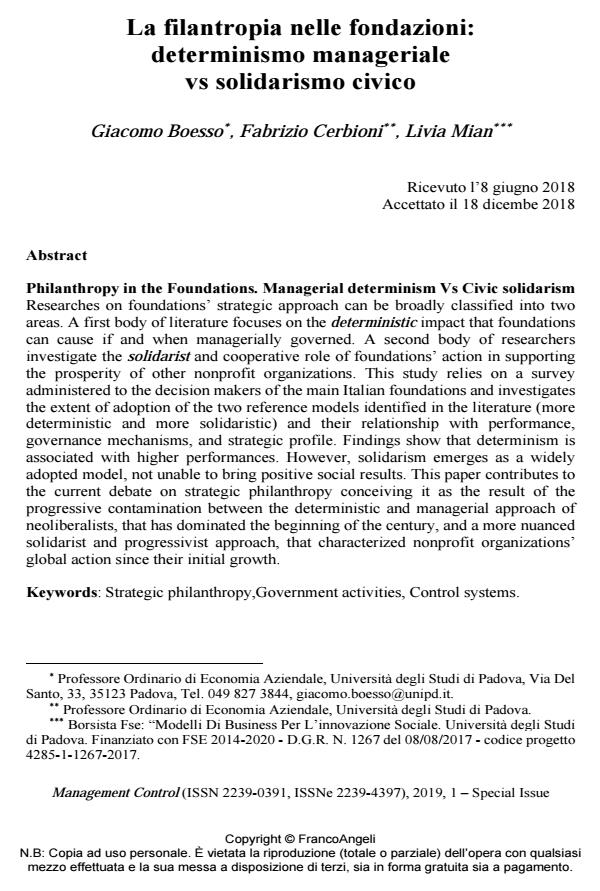La filantropia nelle fondazioni: determinismo manageriale vs solidarismo civico
Titolo Rivista MANAGEMENT CONTROL
Autori/Curatori Giacomo Boesso, Fabrizio Cerbioni, Livia Mian
Anno di pubblicazione 2019 Fascicolo 2019/1 suppl.
Lingua Italiano Numero pagine 24 P. 121-144 Dimensione file 242 KB
DOI 10.3280/MACO2019-SU1007
Il DOI è il codice a barre della proprietà intellettuale: per saperne di più
clicca qui
Qui sotto puoi vedere in anteprima la prima pagina di questo articolo.
Se questo articolo ti interessa, lo puoi acquistare (e scaricare in formato pdf) seguendo le facili indicazioni per acquistare il download credit. Acquista Download Credits per scaricare questo Articolo in formato PDF

FrancoAngeli è membro della Publishers International Linking Association, Inc (PILA)associazione indipendente e non profit per facilitare (attraverso i servizi tecnologici implementati da CrossRef.org) l’accesso degli studiosi ai contenuti digitali nelle pubblicazioni professionali e scientifiche
Researches on foundations’ strategic approach can be broadly classified into two areas. A first body of literature focuses on the deterministic impact that foundations can cause if and when managerially governed. A second body of researchers investigate the solidarist and cooperative role of foundations’ action in supporting the prosperity of other nonprofit organizations. This study relies on a survey administered to the decision makers of the main Italian foundations and investigates the extent of adoption of the two reference models identified in the literature (more deterministic and more solidaristic) and their relationship with performance, governance mechanisms, and strategic profile. Findings show that determinism is associated with higher performances. However, solidarism emerges as a widely adopted model, not unable to bring positive social results. This paper contributes to the current debate on strategic philanthropy conceiving it as the result of the progressive contamination between the deterministic and managerial approach of neoliberalists, that has dominated the beginning of the century, and a more nuanced solidarist and progressivist approach, that characterized nonprofit organizations’ global action since their initial growth.
Parole chiave:Strategic philanthropy,Government activities, Control systems.
Giacomo Boesso, Fabrizio Cerbioni, Livia Mian, La filantropia nelle fondazioni: determinismo manageriale vs solidarismo civico in "MANAGEMENT CONTROL" 1 suppl./2019, pp 121-144, DOI: 10.3280/MACO2019-SU1007